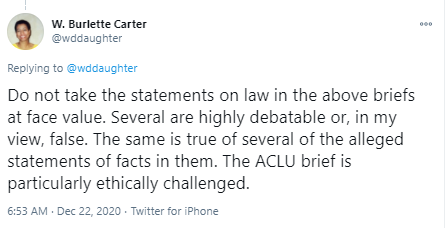Is a particular person was a “woman”? For most of my life, everyone I knew would say that the question is answered by considering what kind of genitals that person had. For many people, the answer to that question is no longer answered purely by biology. And to make the discussion all-the-more confusing, transgender activists insist that “intersex” conditions are relevant to this discussion while others consider intersex a red herring.
Lindsay Hecox v Bradley Little [Governor of Idaho] will weigh in on this issue. This appeal is pending in the Ninth Circuit (and perhaps headed to the United States Supreme Court). The context is transgender sports competition involving students in Idaho. A new Idaho statute is the focus of this lawsuit. The following excerpt is a description of Idaho law taken from the appellate brief of Idaho (the Defendant):
The statute at issue is the Fairness in Women’s Sports Act, Idaho Code §§ 33-6201 through -6206. The Act excludes members of the male sex from participating in sports designated for athletes of the female sex due to males’ physiological advantages, consistent with settled Ninth Circuit law . . . . The Act also permits male and co-ed teams, both of which are open to members of either sex. See Idaho Code § 33-6203.
To ensure the Act’s protections for female athletes, the Act provides that if a dispute arises over a student’s sex and eligibility for female sports, the student may establish female sex in one of three ways: through a high school health examination and consent form signed by a health care provider, which all student-athletes must submit; through another written statement signed by the student’s health care provider; or through a sports physical examination, in which the health care provider relies on one of three specified criteria to determine sex. See Idaho Code § 33-6203(3). See also ER 417-19 (Idaho High School Activities Association Health Examination and Consent Form); IHSAA Rule 13 (requiring high school athletes to submit form). The Act does not provide any sex-verification procedures for male or co-ed sports, because they are open to all, regardless of sex. In support of the bill, the Idaho Legislature made a number of findings based on court decisions, scholarly publications, and scientific studies recognizing the physiological advantages members of the male sex have over their female counterparts. Idaho Code § 33-6202(8)-(11). The Legislature also described the Act’s purpose:
Having separate sex-specific teams furthers efforts to promote sex equality. Sex-specific teams accomplish this by providing opportunities for female athletes to demonstrate their skill, strength, and athletic abilities while also providing them with opportunities to obtain recognition and accolades, college scholarships, and the numerous other long-term benefits that flow from success in athletic endeavors.
Id. § 33-6202(12).
Plaintiffs describe the Idaho law at page 8ff of their brief.
A federal trial court granted an injunction, holding that the above law violates federal law. See the Idaho Brief at pp 6-7 and the Plaintiffs’ brief, pp. 2-4 for more detail. This is a fascinating set of briefs for many reasons, one of them being that if you read both briefs, it is often hard to believe that they are describing the same lawsuit. That is because the crux of the case is whether one of the two plaintiffs, Lindsay Hecox, is more accurately described as male versus female. Consider Hecox’s descriptions in the two briefs:
[From the Plaintiffs’ Brief, p. 15: “Lindsay is a woman athlete living in Idaho who is transgender.” Plaintiffs’ brief includes a photo of Lindsay:
[From Defendant Idaho’s Brief] “One plaintiff is Lindsay Hecox, who is transgender, and whose sex is male but whose gender identity is female.”
Both sides agree that Lindsay is “transgender.” As you can see, Plaintiffs claim she is “a woman” while Idaho states that the “sex is male.”
I haven’t yet read every word of every brief, but I have reviewed a lot of the filings. In case anyone is interested in following along to see exactly what is being claimed as far as the “facts” or the law, you are welcome to click on the links below. My focus is biology, but the Plaintiffs claim that biology does is not determinative.
What does science say about determining one’s “sex” or “gender?” I found that only one of these filings discussed this biology issue in detail and with integrity: The Amicus Brief filed Nov 19, 2020 by Medical Professionals Supporting Idaho. This brief offers a clear persuasive tutorial on what biologists mean by “sex.” Here is an excerpt:
[I]t is vital to distinguish between the quite different categories of sex and gender, because conflating sex with gender swiftly creates confusion. Sex is a fact of human biology. But gender—in its current ideological usage—is an amorphous social construct. . . . Sex is binary and objective, determined by one’s chromosomal constitution that normatively results in clearly defined reproductive capacities . . . Thus, sex is not “assigned” at birth but instead is fixed at conception and “declares itself anatomically in utero and is acknowledged at birth.” . . . Humans reproduce sexually, and the central basis for sex is the distinction between the reproductive roles of males and females.
Who would have ever thought that these things would need to be stated in a brief? But here we are in 2020. In addition to offering a basic biology lesson, this Amicus brief obliterates the conclusions of “Dr. Turban,” an expert witness for Plaintiffs. It does this by pointing out numerous gaping holes in the studies upon which “Dr. Turban” relies, including studies regarding suicide. Plaintiffs’ brief does not have any comparable discussion based on biology. It never mentions the term “gamete.” It is essentially assumed throughout Plaintiff’s brief that a person with male genitalia who declares as a woman is legally a woman for purposes of competing in school sports in Idaho.
The brief of of the medical professionals supporting the Plaintiff was filed by an impressive Who’s Who of medical organizations, including the American Medical Association, American Psychiatric Association, The Association of LGBTQ Psychiatrists, American Medical Women’s Association, American Nurses Association, Pediatric Endocrine Society, the National Council for Behavioral Health and American Public Health Association. The brief relies heavily upon the claim that its position is the “consensus” position. That position is essentially (and uncritically) that many people identify as transgender:
According to a recent report by the Centers for Disease Control and Prevention (“CDC”), approximately 1.8 percent of high school students—roughly 300,000 high school students nationwide—identify as transgender. If the CDC’s 1.8 percent figure is applied to all college and university students across the United States, roughly 350,000 identify as transgender. Thus, a total of approximately 650,000 secondary and post-secondary school students nationwide identify as transgender.
The brief then indicates that “many” of these people “experience a condition called gender dysphoria, which is characterized by clinically significant distress resulting from the incongruence between one’s gender identity and the sex assigned to the individual at birth.” The brief does not mention the concern raised by Abigail Shrier, the recent explosion of new cases (over the past decade), involving young girls based primarily upon self-diagnosis, urged on by activists and peers through social media. It doesn’t add up that so many boys would suddenly be born in girls bodies. These large medical organizations don’t mention that the large majority of these people claim transgender status are basing this on self-diagnosis, without a formal diagnosis and without a differential diagnosis. They don’t rule out social contagion as a highly suspicious possibility. They don’t discuss the phenomenon of rapid onset gender dysphoria. Their position is that sexual dysphoria, even if diagnosed by a 12 year old, is definitive. If a biological teenage girl thinks she is a boy, she is a boy. Is that how dysphoria really works? If you think it is so, it must be? That approach, applied widely, would revolutionize health treatment. That would be as absurd as telling someone suffering from phantom limb pain that they really have that limb. This approach means that, from now on, mental health professionals should ignore their rigorous training and simply assume that the patient is always correct, even if that patient is is 13 years old and confounding factors are apparent.
The Plaintiff’s medical organizations also urges us to treat transgender people with compassion. Absolutely, but that’s putting the cart before the horse. Here’s one more excerpt from the Plaintiff’s medical experts exhibiting an Olympic level of hedging on causation. This is not impressive science. And again, these are supposedly professionals. Where is the differential diagnosis?
Psychologists, psychiatrists, and neuroscientists are not certain why some people are transgender. Some research suggests there may be biological influences,21 including, for example, exposure of transgender men identified at birth as females to elevated levels of testosterone in the womb.22 Brain scans and neuroanatomical studies of transgender individuals may also support these biological explanations.
Referring to the Briefs in favor of the Plaintiffs, law professor W. Burlette Carter offers this caveat:
Enjoy the briefs:
Defendant (Idaho) Brief
Plaintiff’s Brief (filed by ACLU)
Medical Professionals Amicus Brief (file on behalf of Defendant)
Medical Professionals Amicus Brief (file on behalf of Plaintiff)
Women Athlete’s Amicus Brief (Filed on behalf of Plaintiffs)
Woman’s Liberation Front Amicus Brief (Filed on behalf of Defendant).



